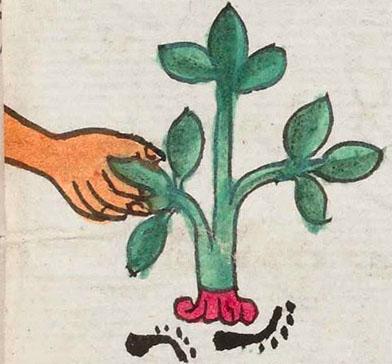Xomeyocan (Mdz29r)
This compound glyph for the place name Xomeyocan consists of an elder tree (xometl), an arm with hand (maitl) painted a terracotta color, and footprints (xo). The tree looks something like a leafy shrub, with a leader and two branches painted a two-tone green color. It has visible, above-ground, red roots. The (right) hand comes from the left, almost horizontal, and it holds one of the leaves. The two footprints that appear at the bottom of this compound are black, alternating footprints, going in the direction of the viewer's right. The locative suffix (-can) is not shown visually, but perhaps the landscape provides a semantic locative.
Stephanie Wood
The footprints represent the noun for road (otli), providing a phonetic value for the "yo" element, which refers to a place that has a "lot of" something or is "full of" something. This differs from the footprint on top of a hill, which more typically indicates the verb pano (to cross over), providing the phonetic value of the locative suffix -pan, such as can also be seen in the compound glyphs for Tlaltizapan, Ocpayocan, Xomeyocan, and Xocoyocan. [See Gordon Whittaker Deciphering Aztec Hieroglyphs, 2021, 100.]
Footprint glyphs have a wide range of translations. In this collection, so far, we can attest to yauh, xo, pano, -pan, paina, temo, nemi, quetza, otli, iyaquic hualiloti, huallauh, tetepotztoca, totoco, -tihui, and the vowel "o." Other research (Herrera et al, 2005, 64) points to additional terms, including: choloa, tlaloa, totoyoa, eco, aci, quiza, maxalihui, centlacxitl, and xocpalli.
The elder tree (xometl) could be sufficient as a clue to the place name, but the added elements in the compound appear to be phonetic complements (xo + ma) to help the viewer reach the reading of "xome". The -e and the -a can be interchangeable, such as we see in the verb pia (to have/keep), which is sometimes spelled piye.
A hand in this activity could be read to capture or take, (ma), which really just underlines the phonetic reading of the "me" in the place name.
Stephanie Wood
xomeyocan. puo
Xomeyocan pueblo
Stephanie Wood
c. 1541, or by 1553 at the latest
Stephanie Wood
nombres de lugares

xome(tl), elder tree, https://nahuatl.wired-humanities.org/content/xometl
xo, foot or relating to feet, https://nahuatl.wired-humanities.org/content/xo
ma, to capture or take, https://nahuatl.wired-humanities.org/content/ma-0
ma(itl), hand or arm, https://nahuatl.wired-humanities.org/content/maitl
-yocan, place where there is a lot of (the preceding noun), https://nahuatl.wired-humanities.org/content/yocan
-yo(tl)-, having that characteristic or quality/inalienable possession, https://nahuatl.wired-humanities.org/content/yotl
-can (locative suffix), where, https://nahuatl.wired-humanities.org/content/can-2
Place Characterized by Elder Trees
Lugar Conocido Por Los Saucos
Stephanie Wood
Codex Mendoza, folio 29 recto, https://digital.bodleian.ox.ac.uk/objects/2fea788e-2aa2-4f08-b6d9-648c00..., image 68 of 188.
The Bodleian Libraries, University of Oxford, hold the original manuscript, the MS. Arch. Selden. A. 1. This image is published here under the UK Creative Commons, “Attribution-NonCommercial-ShareAlike 3.0 License” (CC-BY-NC-SA 3.0).




